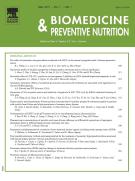Isolation and characterization of catechol derivatives from Semecarpus anacardium seeds and their antibacterial potential in in vitro - 30/05/14
 , Panchanatham Sachdanandam a
, Panchanatham Sachdanandam aAbstract |
The aim of the present investigation was to isolate and identify the phytochemicals from Semecarpus anacardium seeds and evaluate their activity against Gram positive and Gram negative bacterial strains (Bacillus subtilis MTCC 441, Staphylococcus aureus MTCC 96, Escherichia coli MTCC 1689 and Proteus vulgaris MTCC 742 using well diffusion method). The phytochemicals were isolated using silica gel column chromatography and characterized as catechol derivatives by spectroscopic analyses. The antimicrobial activity of the isolated catechol derivatives I-IV varied according to the dose and bacterial strains tested. Among the four catechol derivatives, catechol derivatives I and IV showed prominent antibacterial activity against both the positive and negative human pathogenic organisms compared to catechol derivatives II, III and tetracycline – a reference antibiotic drug. From these findings, it can be concluded that catechol derivatives I and IV possessed methyl group (CH3) in aromatic ring and no double bond in the aliphatic side chain which was not present in catechol derivatives II and III and they possessed double bonds in the aliphatic side chain and no methyl group in the aromatic ring. These may be the possible reason for showing more inhibitory activity of catechol derivatives I and IV. These results showed the effectiveness of catechol derivatives against tested bacterial strains. Further work is necessary to explore these antimicrobial compounds, which are useful in clinical applications.
Le texte complet de cet article est disponible en PDF.Keywords : Semecarpus anacardium, Catechol derivatives, Antibiotic resistance, Staphylococcus aureus, Escherichia coli, Bacillus subtilis
Plan
Vol 4 - N° 2
P. 177-180 - avril 2014 Retour au numéroBienvenue sur EM-consulte, la référence des professionnels de santé.
L’accès au texte intégral de cet article nécessite un abonnement.
Déjà abonné à cette revue ?

